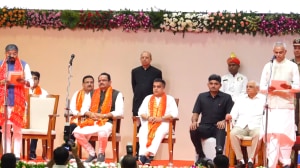Women, in a broken mirror
Join the dots. A baby girl gets abandoned in a hospital in Andhra Pradesh’s Karimnagar as her parents attempt to swap her for someone e...

Join the dots. A baby girl gets abandoned in a hospital in Andhra Pradesh’s Karimnagar as her parents attempt to swap her for someone else’s infant with the right genitals. The 2001 census reveals that the child sex ratio in Punjab has touched an all-time low, with just 793 girls for 1000 boys— and the unstated salespitch for female foeticide here is that if you spend Rs 15,000 now on an ultrasound test and abortion, you could save Rs 1.5 lakh in dowry later. In Noida, a bridegroom demands more marriage loot from the father of a young woman called Nisha Sharma and humiliates him to the point that his daughter decides to walk out of the wedding mandap. Keep joining the dots and the familiar dynamic between the female-child-with-no-name and the devalued woman/ bride/ wife presents itself.
Yet, for as long as we can remember, we have struggled against the practice of dowry. Like a wart, we teased it and masked it and attempted to excise it. Yet it kept growing, assuming grotesque proportions over the years. It went against everything we gave expression to in the Constitution and mocked our intentions to emerge as a modern, egalitarian nation. Dowry was the topic of some of the first women-centric debates in Parliament. This was what one MP said during the debates which ushered in the Dowry Prohibition Act of 1961: “The problem will be solved, not by legislation, but by rousing social conscience…As soon as our women get economic opportunities and economic freedom, as soon as avenues of employment and other opportunities are opened to them, as soon as they become independent of their families, possibly there would not be any occasion for this law…”
A little over a decade later, the Committee on the Status of Women in India observed dryly that “there is hardly any evidence of ‘social conscience’ in this country today”. The Committee believed that unless the practice of dowry was made a cognizable offence, dowry would continue. But since that could lead to harassment of innocent citizens by the police and an undue invasion of privacy, it also suggested that the enforcement of such sensitive laws should be entrusted to a separate administration ‘‘with which social workers and enlightened members of the community should be associated’’. A good idea. And the subsequent years saw many good ideas. A whole movement grew around the issues of dowry and rape. Numerous petitions were signed, meetings with prime ministers held, rallies and street plays staged, newspaper articles written. The objective was three-fold: to expose the crime by bringing it outside the four walls of the home, to make the criminal-justice system more effective in combating it and to ensure the social delegitimisation of the practice.
Looking back, the first and second objectives met with partial success. By the mid-eighties, those notorious “stove deaths” were exposed for what they were, as also the fact that it was, invariably, women in the age group of 15-25 who died in this manner and often in the first year of their marriage. The law now punished husbands and his relatives for ‘‘cruelty’’ to women. The police were also required to investigate ‘‘suspicious cases’’ and the categories under which prosecution could take place were expanded. The manner in which the police went about this was often dubious. In some cases, there were accusations of the law being misused by women to blackmail husbands or harass their families.
While the changes in criminal law had some purpose, the Dowry Prohibition (Amendment) Act, when it was enacted in 1984, proved to be a damp squib. Not only was no ceiling placed on the number of gifts that could be presented, the giving of dowry continued to be viewed as much of an offence as the receiving of it, which ensured that any chance of prosecution was virtually nullified. Which father of the bride would want to risk imprisonment by pursuing such a case?
The pact of silence in the name of the ‘‘family honour’’ of both parties in this crime thus remained largely intact, even as women continued to die—as they still do—in ever-increasing numbers. There has been a 4.4 per cent increase in such deaths in the 21st century, according to official figures. How do we explain, then, that in half a century we have not been able to alter the destiny of these hapless women? That the only material difference between then and now is that it may have been a Bajaj scooter that caused the dispute 40 years ago, while it could be Ford Ikon today?
This, then, is a story of India’s unfinished gender revolution. The reason for this abysmal failure can be traced to the fact that the movement failed to achieve its third objective: the social delegitimisation of dowry. While the practice seeped into communities that were once free of it—reports of dowry now marking Muslim marriages are not uncommon—protesting the practice was increasingly seen as a fringe concern. The state, in many ways, coopted the movement. The ministry for women and child development and bodies like the National Commission for Women displayed alacrity in voicing official disapproval over dowry violence, and conducting Women’s Day seminars on it. Over time, these displays of formal concern replaced the outrage, the idealism, the energy, that women in the late 70s and 80s displayed. With time even the media gaze shifted elsewhere. Dowry deaths no longer made news except, perhaps, when feisty women like Nisha Sharma stirred the air a bit.
So what went wrong? How did an initiative that showed promise fail to translate into a sustainable, transformative process? Was the narrow focus on dowry and violence insufficient in reforming deep gender asymmetries? Was there a need to address wider socio-economic causes and link up with other social movements in a more concerted fashion? Was there adequate assessment of the institution of marriage itself, founded as it was on patrilineal interests which regarded a married woman as a daughter-in-law first and wife later? What about women’s right to property, both parental and matrimonial? Was fighting for rights sufficient or was there also need to battle against those factors— social, economic and cultural—that prevent those rights from becoming our common reality?
The monstrous wart called dowry, that we doggedly carry with us deeper into the 21st century, can only grow, helped by a renewed valorisation of feudal values through gripping tele-dramas, the rise of religious fundamentalisms and a pervasive media apathy. How do we excise it? Or have we grown so used to its ugliness that it doesn’t worry us anymore?





- 01
- 02
- 03
- 04
- 05


























